1998 CHEVROLET MALIBU tire size
[x] Cancel search: tire sizePage 181 of 362
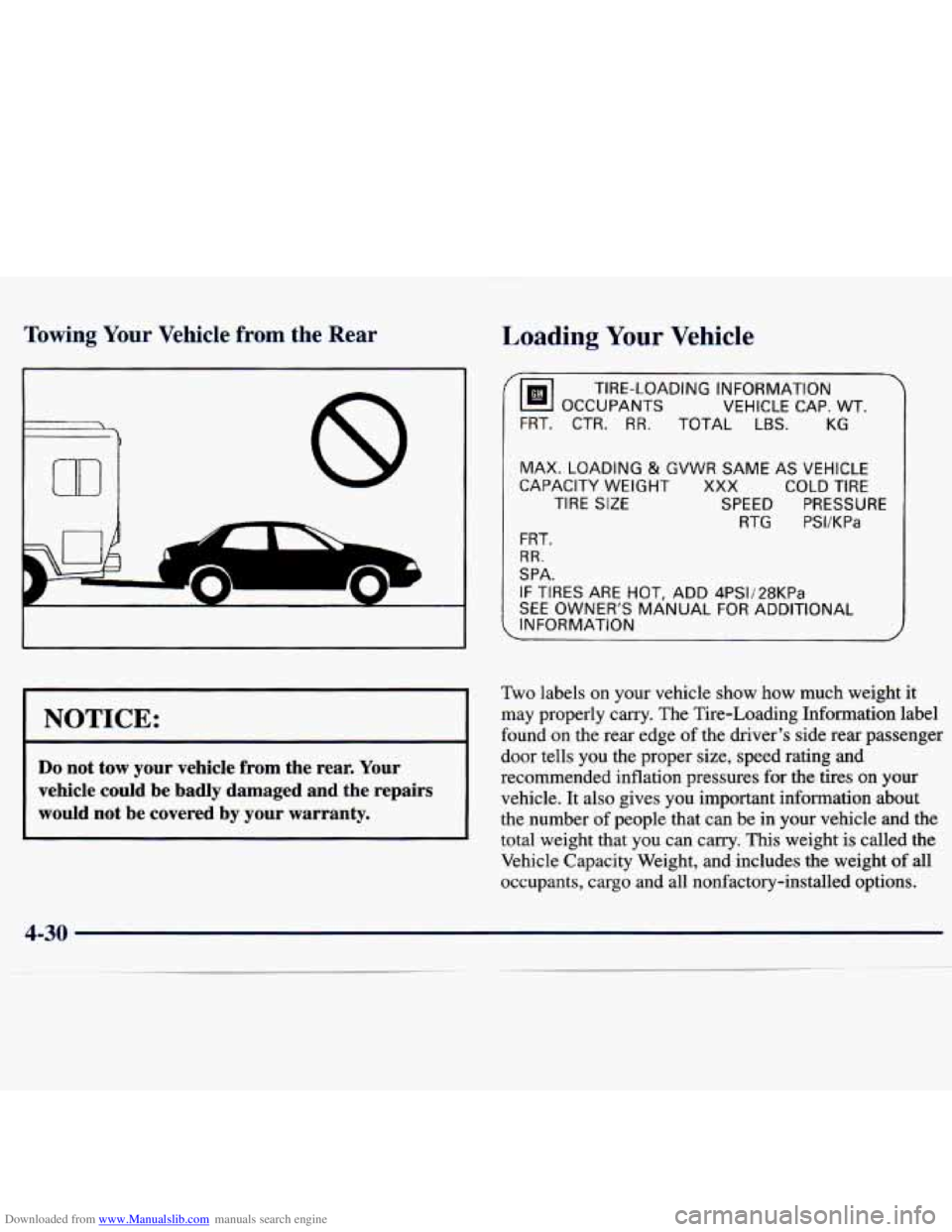
Downloaded from www.Manualslib.com manuals search engine Towing Your Vehicle from the Rear
I NOTICE:
Do not tow your vehicle from the rear. Your
vehicle could be badly damaged and the repairs
would not be covered by your warranty.
Loading Your Vehicle
i"
TIRE-LOADING INFORMATION
OCCUPANTS
VEHICLE CAP. WT.
FRT, CTR. RR. TOTAL LBS. KG
MAX. LOADING & GVWR SAME AS VEHICLE
CAPACITY
WEIGHT XXX COLD TIRE
TIRE SIZE SPEED PRESSURE
RTG PSI/KPa
FRT.
RR.
SPA.
IF TIRES ARE HOT, ADD 4PSIi28KPa
SEE OWNER'S MANUAL FOR ADDITIONAL
, INFORMATION
Two labels on your vehicle show how much weight it
may properly carry. The Tire-Loading Information label
found on
the rear edge of the driver's side rear passenger
door tells you the proper size, speed rating and
recommended inflation pressures for the tires on your
vehicle. It also gives you important information about
the number
of people that can be in your vehicle and the
total weight that you can
carry. This weight is called the
Vehicle Capacity Weight, and includes the weight
of all
occupants, cargo and all nonfactory-installed options.
4-30
Page 222 of 362
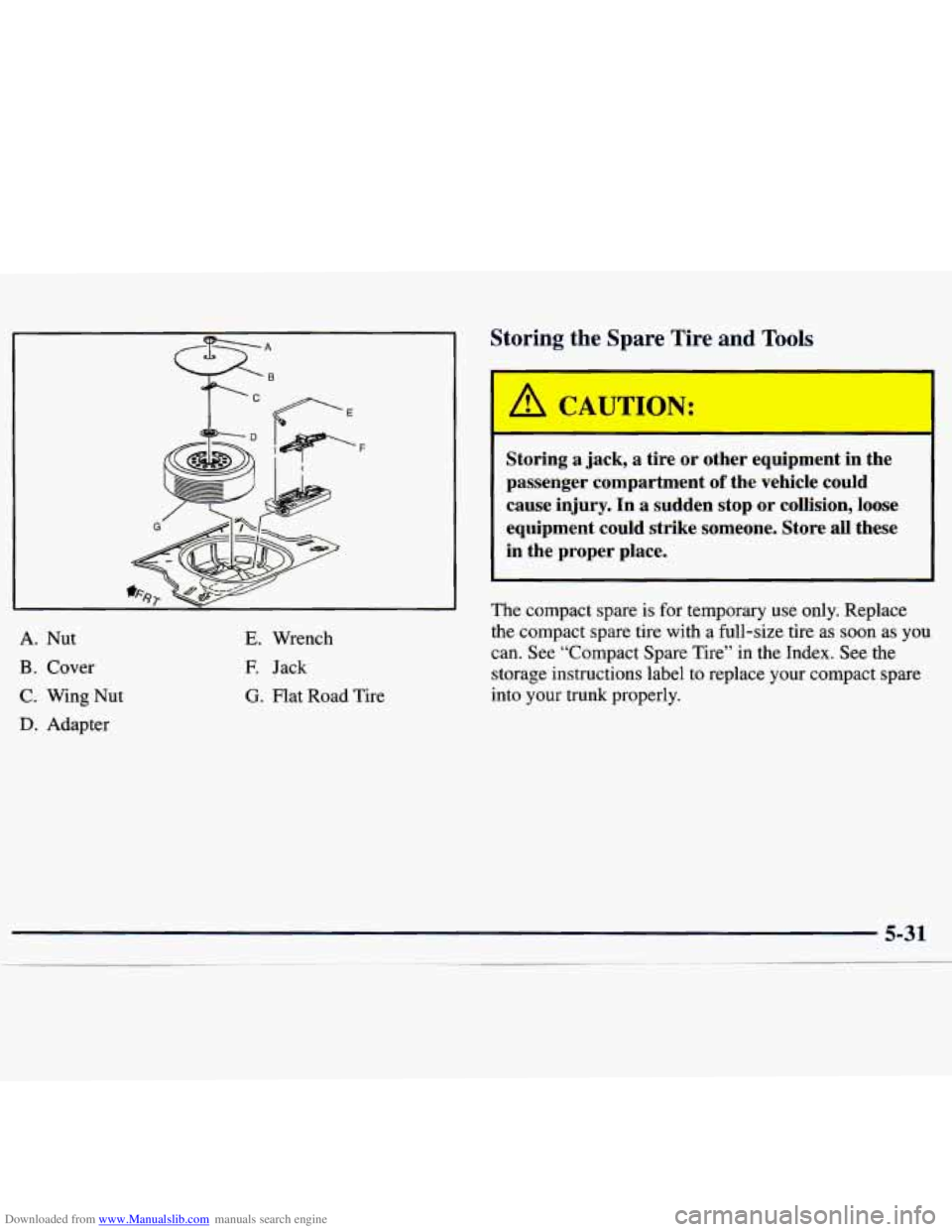
Downloaded from www.Manualslib.com manuals search engine A. Nut
B. Cover
C. Wing Nut
D. Adapter
E. Wrench
E Jack
G. Flat Road Tire
Storing the Spare Tire and Tools
r
A CAUTION:
-
Storing a jack, a tire or other equipment in the
passenger compartment
of the vehicle could
cause injury. In a sudden stop or collision,
loose
equipment could strike someone. Store all these
in the proper place.
The compact spare is for temporary use only. Replace
the compact spare tire with
a full-size tire as soon as you
can. See “Compact Spare Tire” in the Index. See the
storage instructions label to replace your compact spare
into your trunk properly.
I
Page 223 of 362
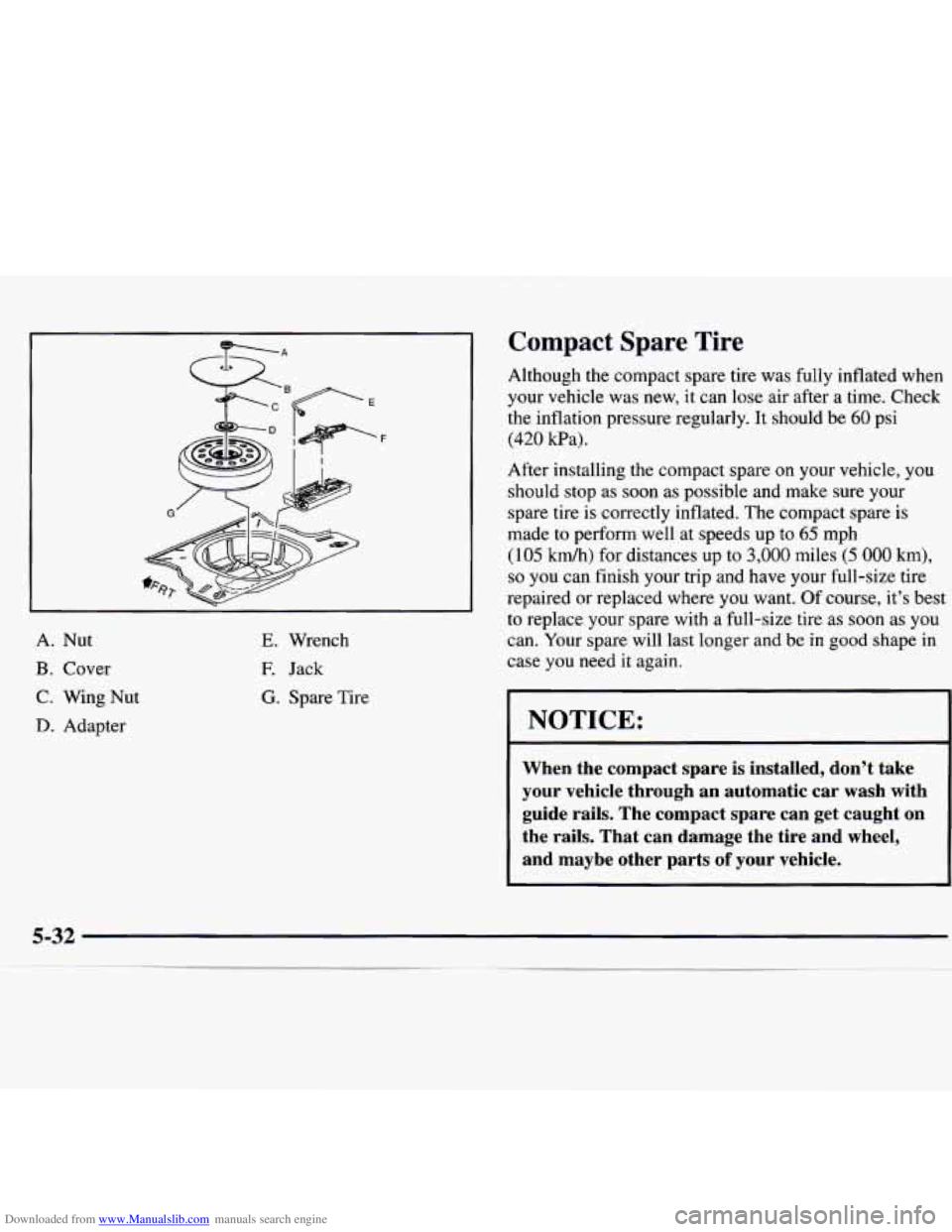
Downloaded from www.Manualslib.com manuals search engine ‘F
A. Nut
B. Cover
C. Wing Nut
D. Adapter
E. Wrench
E Jack
G. Spare Tire
Compact Spare Tire
Although the compact spare tire was fully inflated when
your vehicle was new, it can lose air after a time. Check
the inflation pressure regularly.
It should be 60 psi
(420 kPa).
After installing the compact spare on your vehicle, you
should stop as soon as possible and make sure your
spare tire is correctly inflated. The compact spare is
made to perform well at speeds up to 65 mph
(105 kdh) for distances up to
3,000 miles (5 000 km),
so you can finish your trip and have your full-size tire
repaired or replaced where you want. Of course, it’s best
to replace your spare with a full-size tire as soon as you
can. Your spare will last longer and be in good shape in
case you need it again.
I NOTICE:
When the compact spare is installed, don’t take
your vehicle through an automatic car wash with
guide rails. The compact spare can get caught on
the rails. That can damage the tire and wheel,
and maybe other parts
of your vehicle.
Page 265 of 362
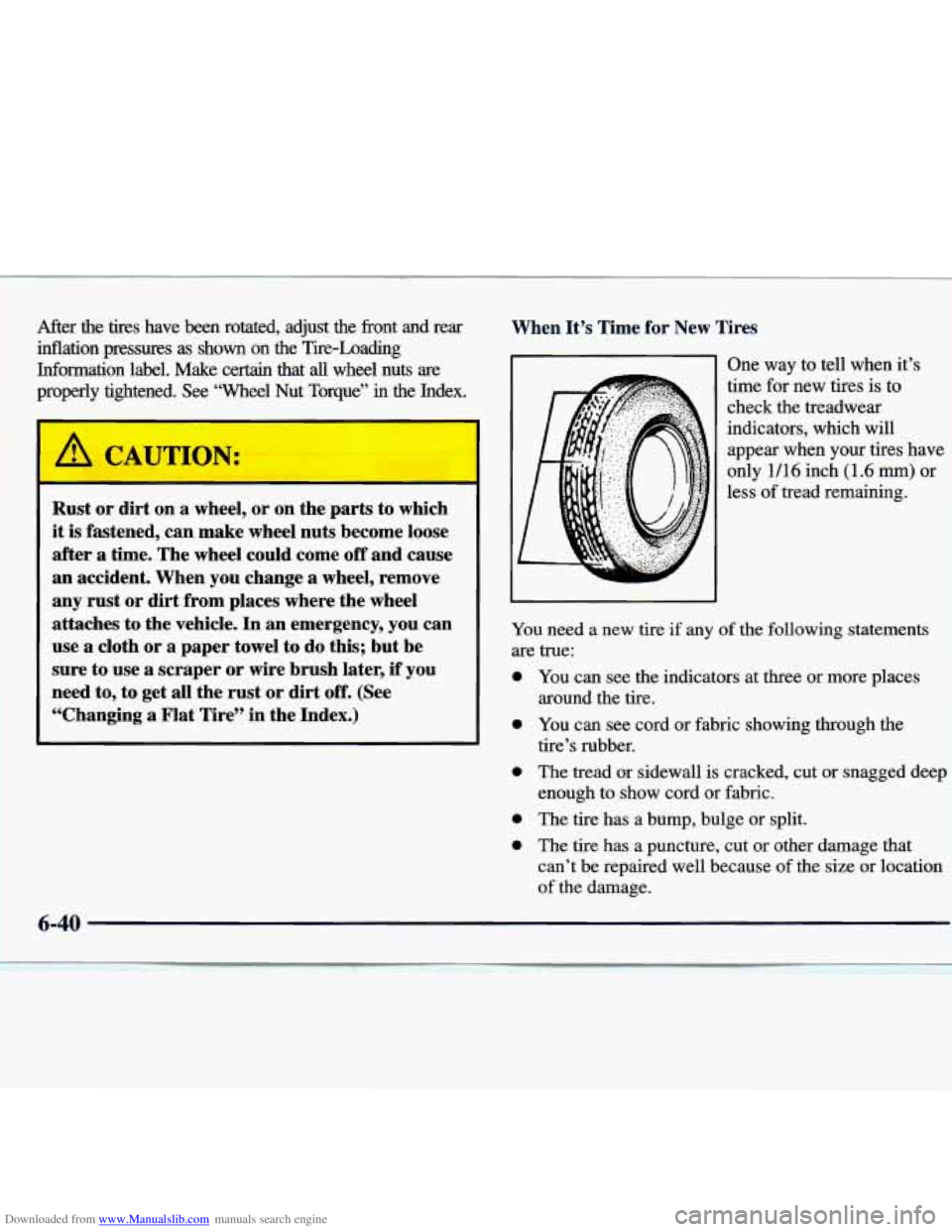
Downloaded from www.Manualslib.com manuals search engine After the tires have been rotated, adjust the front and rear
inflation pressures as shown on the Tire-Loading
Information label. Make certain that
all wheel nuts are
properly tightened.
See ‘Wheel Nut Torque” in the Index.
’ A YAUTION:
F-
Rust or dirt on a wheel, or on the parts to which
it
is fastened, can make wheel nuts become loose
after
a time. The wheel could come off and cause
an accident. When you change a wheel, remove
any rust or dirt from places where the wheel
attaches
to the vehicle. In an emergency, you can
use a cloth
or a paper towel to do this; but be
sure to use a scraper
or wire brush later, if you
need to, to get all the rust or dirt off. (See
“Changing a Flat Tire” in the Index.) When It’s Time
for
New Tires
One way to tell when it’s
time for new tires is
to
check the treadwear
indicators, which will appear when your tires have
only
1/16 inch (1.6 mm) or
less of tread remaining.
You need a new tire if any of the following statements
are true:
0 You can see the indicators at three or more places
0 You can see cord or fabric showing through the
0 The tread or sidewall is cracked, cut or snagged deep 1
around the tire.
tire’s rubber.
enough
to show cord or fabric.
0 The tire has a bump, bulge or split.
0 The tire has a puncture, cut or other damage that
can’t be repaired well because of the size or location
of the damage.
6-40
Page 266 of 362
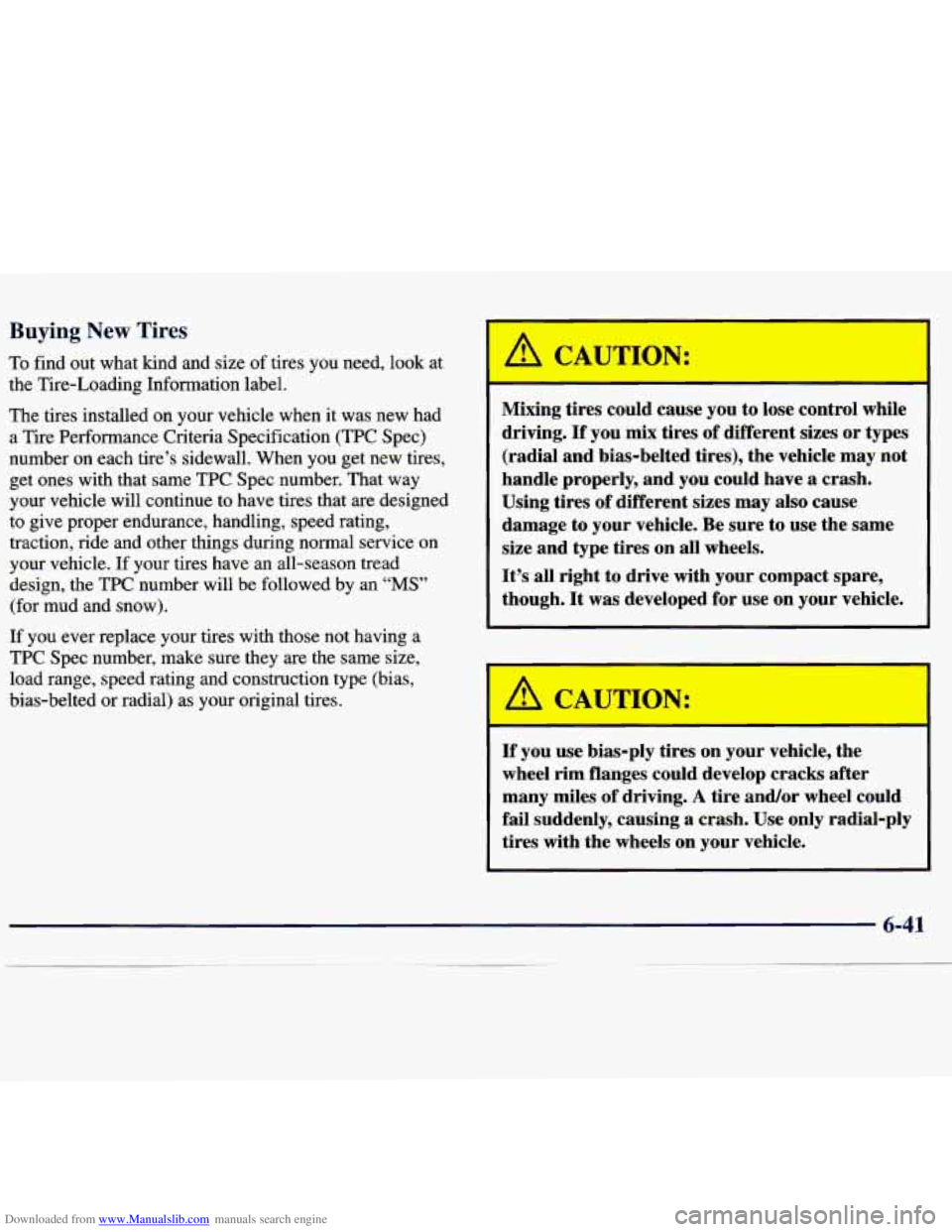
Downloaded from www.Manualslib.com manuals search engine Buying New Tires
To find out what kind and size of tires you need, look at
the Tire-Loading Information label.
The tires installed on your vehicle when it was new had
a Tire Performance Criteria Specification (TPC Spec)
number on each tire’s sidewall. When you get new tires,
get ones with that same
TPC Spec number. That way
your vehicle will continue to have tires that are designed
to give proper endurance, handling, speed rating,
traction, ride and other things during normal service on
your vehicle.
If your tires have an all-season tread
design, the TPC number will be followed by an
“MS”
(for mud and snow).
If you ever replace your tires with those not having a
TPC Spec number, make sure they are the same
size,
load range, speed rating and construction type (bias,
bias-belted or radial) as your original tires. Mixing tires could
cause you to lose control while
driving.
If you mix tires of different sizes or types
(radial and bias-belted tires), the vehicle may not
handle properly, and you could have
a crash.
Using tires
of different sizes may also cause
damage to your vehicle. Be sure to use the same
size and type tires on all wheels.
It’s
all right to drive with your compact spare,
though.
It was developed for use on your vehicle.
If you use bias-ply tires on your vehicle, the
wheel rim flanges could develop cracks after
many miles of driving.
A tire and/or wheel could
fail suddenly, causing a crash. Use only radial-ply
tires with the wheels on your vehicle.
Page 270 of 362
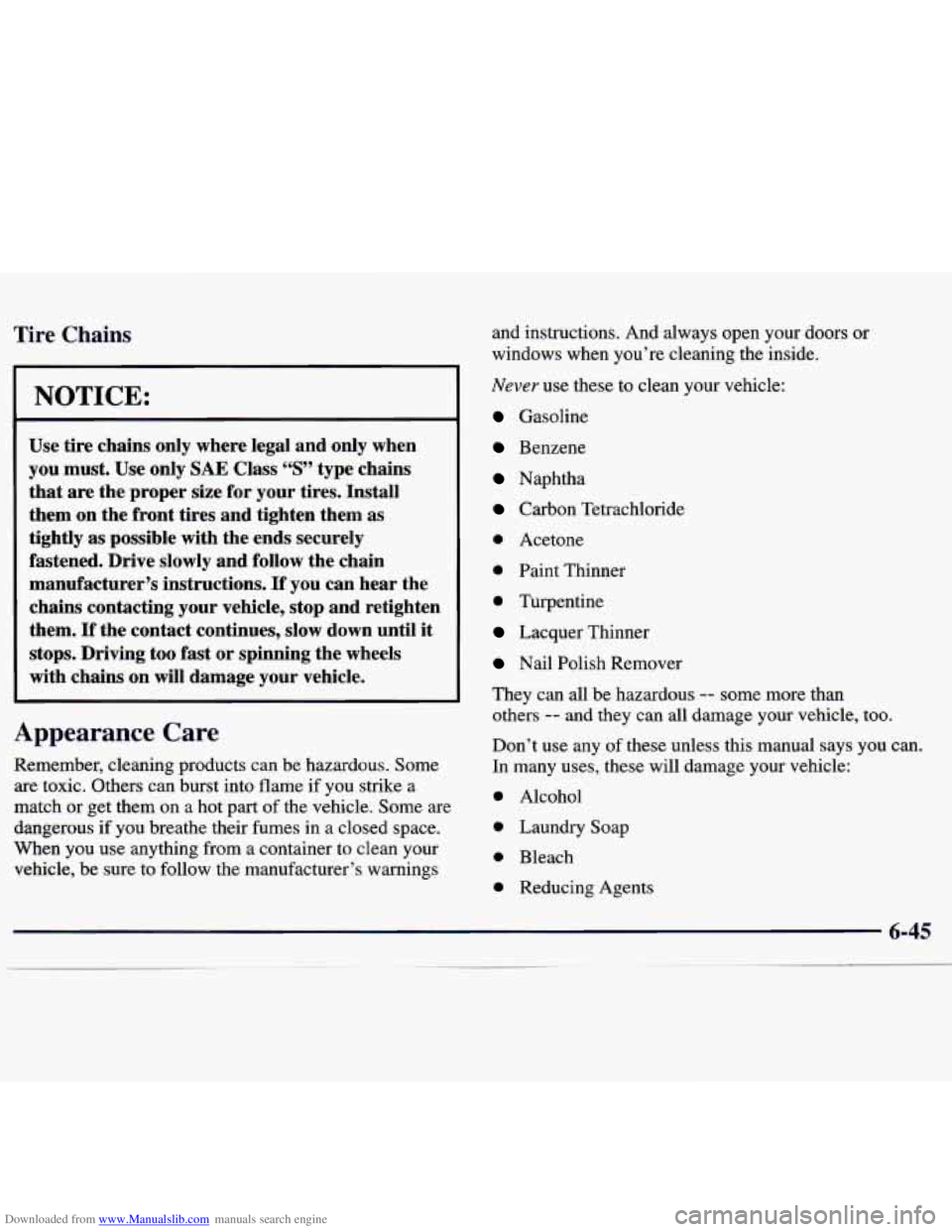
Downloaded from www.Manualslib.com manuals search engine r rire Chains
NOTICE:
Use tire chains only where legal and only when
you must. Use only
SAE Class “S” type chains
that are the proper size
for your tires. Install
them on the front tires and tighten them as
tightly as possible with the ends securely
fastened. Drive slowly and follow the chain
manufacturer’s instructions.
If you can hear the
chains contacting your vehicle, stop and retighten
them.
If the contact continues, slow down until it
stops. Driving too fast or spinning the wheels
with chains on will damage your vehicle.
Appearance Care
Remember, cleaning products can be hazardous. Some
are toxic. Others can burst into flame if you strike a
match or get them on a hot part of the vehicle. Some are
dangerous if you breathe their fumes in a closed space.
When you use anything from a container to clean your
vehicle, be sure to follow the manufacturer’s warnings and instructions. And always open your
doors or
windows when you’re cleaning the inside.
Never use these to clean your vehicle:
Gasoline
Benzene
Naphtha
Carbon Tetrachloride
0 Acetone
0 Paint Thinner
0 Turpentine
Lacquer Thinner
Nail Polish Remover
They can all be hazardous
-- some more than
others
-- and they can all damage your vehicle, too.
Don’t use any
of these unless this manual says you can.
In many uses, these will damage your vehicle:
0 Alcohol
0 Laundry Soap
0 Bleach
0 Reducing Agents
Page 278 of 362
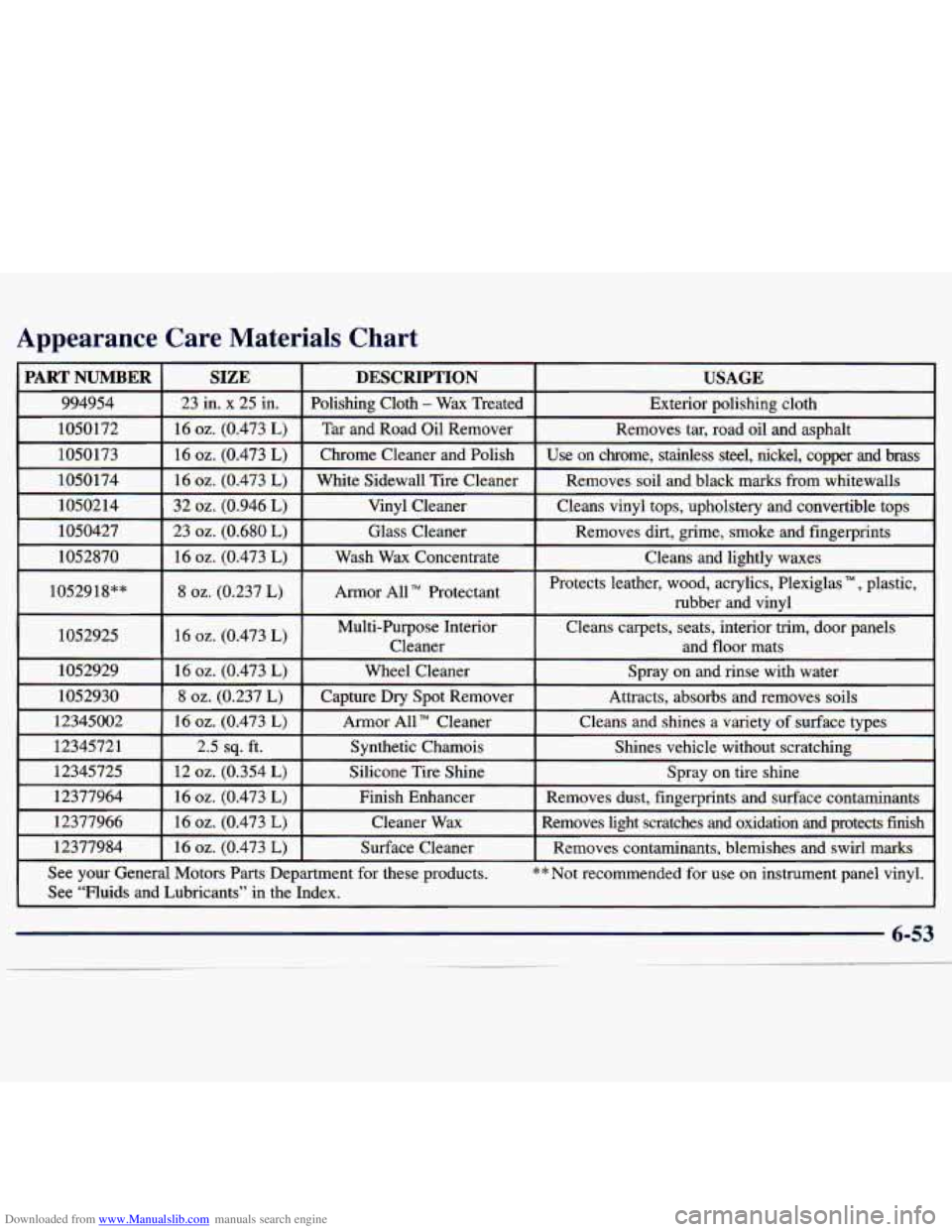
Downloaded from www.Manualslib.com manuals search engine Appearance Care Materials Chart
PART NUMBER
994954
1050172
1050173
1050174
1050214
1050427
1052870
I 1052918””
1 1052925
I 1052929
SIZE DESCRIPTION
23 in. x 25 in. Polishing; Cloth - Wax Treated
16
oz. (0.473 L) I Tar and Road Oil Remover
16
oz. (0.473 L) I Chrome Cleaner and Polish
16
oz. (0.473 L) I White Sidewall Tire Cleaner
32
oz. (0.946 L) Vinyl Cleaner
23
oz. (0.680 L) Glass Cleaner
16
02. (0.473 L) Wash Wax Concentrate
8 oz. (0.237 L) Armor All“ Protectant
-
USAGE
Exterior polishing cloth
emoves tar, road oil and asphalt
Use on chrome, stainless steel, nickel, copper and
brass
Removes soil and black marks from whitewalls
Cleans vinyl tops, upholstery and convertible tops Removes dirt, grime, smoke and fingerprints
Cleans and lightly waxes
Protects leather, wood, acrylics, Plexiglas
TM, plastic,
rubber and vinvl
16
oz. (0.473 L)
16 oz. (0.473 L) Wheel Cleaner Spray on and rinse with water
8 oz. (0.237 L) Capture Dry Spot Remover
Attracts, absorbs and removes soils
16
oz. (0.473 L) Armor All” Cleaner Cleans and shines a varietv of surface tvDes
Multi-Purpose Interior Cleans carpets, seats, interior trim, door\
panels
Cleaner and floor mats I I I d
I 12345721 I 2.5 sq. ft. I Synthetic Chamois I Shines vehicle without scratching 1
.,A
12345725 12 oz. (0.354 L) Silicone Tire Shine Spray on tire shine
12377964
See your General Motors
Parts Department for these products. **Not recommended for use on ins\
trument panel vinyl.
16
oz. (0.473 L) Surface Cleaner Removes contaminants, blemishes and swirl marks
12377984
16 oz. (0.473 L) Cleaner Wax Removes light scratches and oxidation a\
nd protects finish
12377966 16
oz. (0.473 L) Finish Enhancer Removes dust, fingerprints and surface contaminan\
ts
See “Fluids and Lubricants” in the Index.
-
6-53
Page 287 of 362
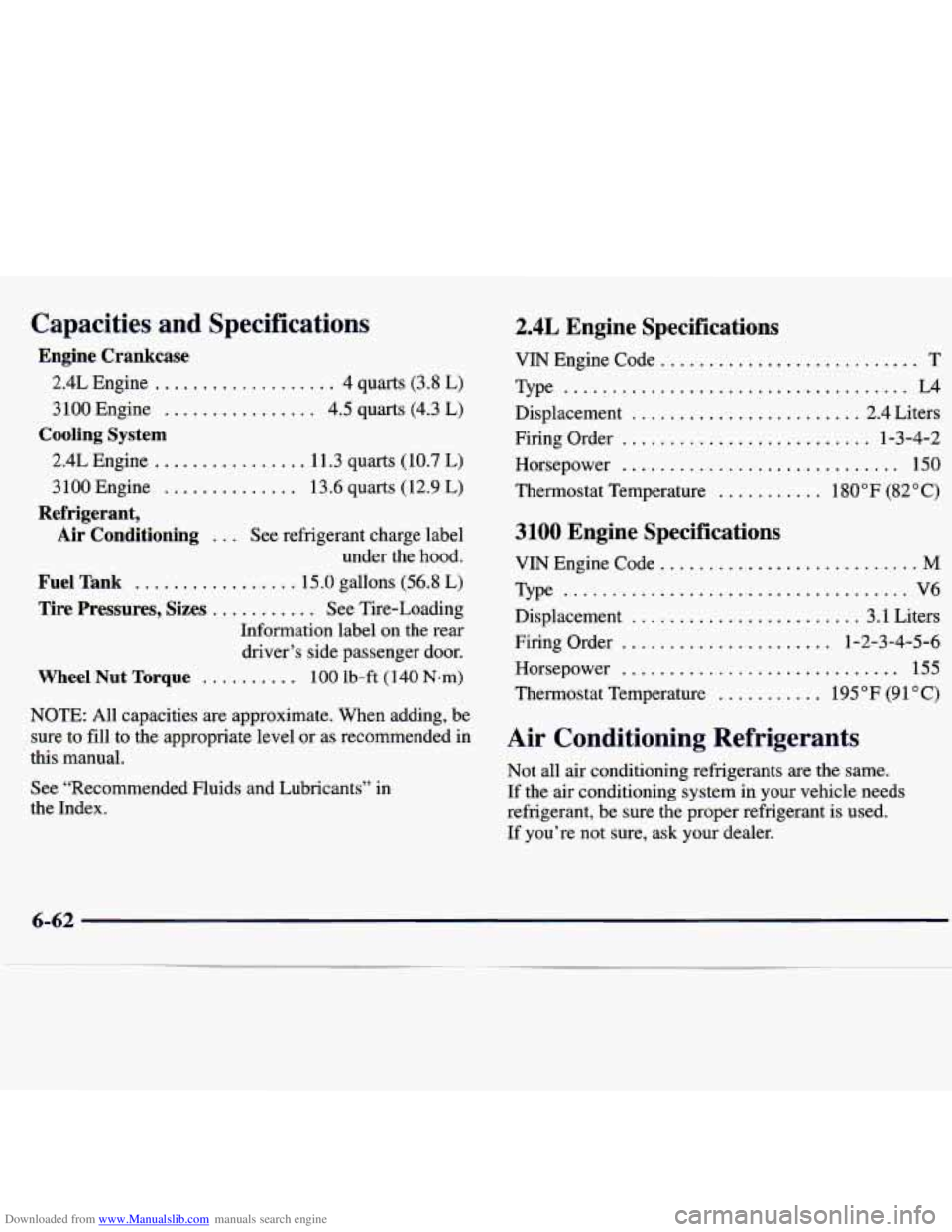
Downloaded from www.Manualslib.com manuals search engine Capacities and Specifications
Engine Crankcase
2.4L Engine ................... 4 quarts (3.8 L)
3 100 Engine
................ 4.5 quarts (4.3 L)
2.4LEngine ................ 11.3quarts(10.7L)
3100 Engine .............. 13.6 quarts (12.9 L)
Air Conditioning ... See refrigerant charge label
under the hood.
Fuel Tank ................. 15.0 gallons (56.8 L)
Information label on the rear
driver’s side passenger door.
Wheel Nut Torque .......... 100 lb-ft (140 Nsm)
Cooling System
Refrigerant,
Tire Pressures, Sizes
........... See Tire-Loading
NOTE: All capacities are approximate. When adding, be
sure to fill
to the appropriate level or as recommended in
this manual.
See “Recommended Fluids and Lubricants” in
the Index.
2.4L Engine Specifications
VIN Engine Code ........................... T
Type .................................... L4
Displacement ........................ 2.4 Liters
Firing Order
.......................... 1-3-4-2
Horsepower
............................. 150
Thermostat Temperature ........... 180°F (82°C)
3100 Engine Specifications
VIN Engine Code ........................... M
Type .................................... V6
Displacement
........................ 3.1 Liters
Firing Order
...................... 1-2-3-4-5-6
Horsepower
............................. 155
Thermostat Temperature
........... 195 OF (9 1 O C)
Air Conditioning Refrigerants
Not all air conditioning refrigerants are the same.
If the air conditioning system in your vehicle needs
refrigerant,
be sure the proper refrigerant is used.
If you’re not sure, ask your dealer.
6-62